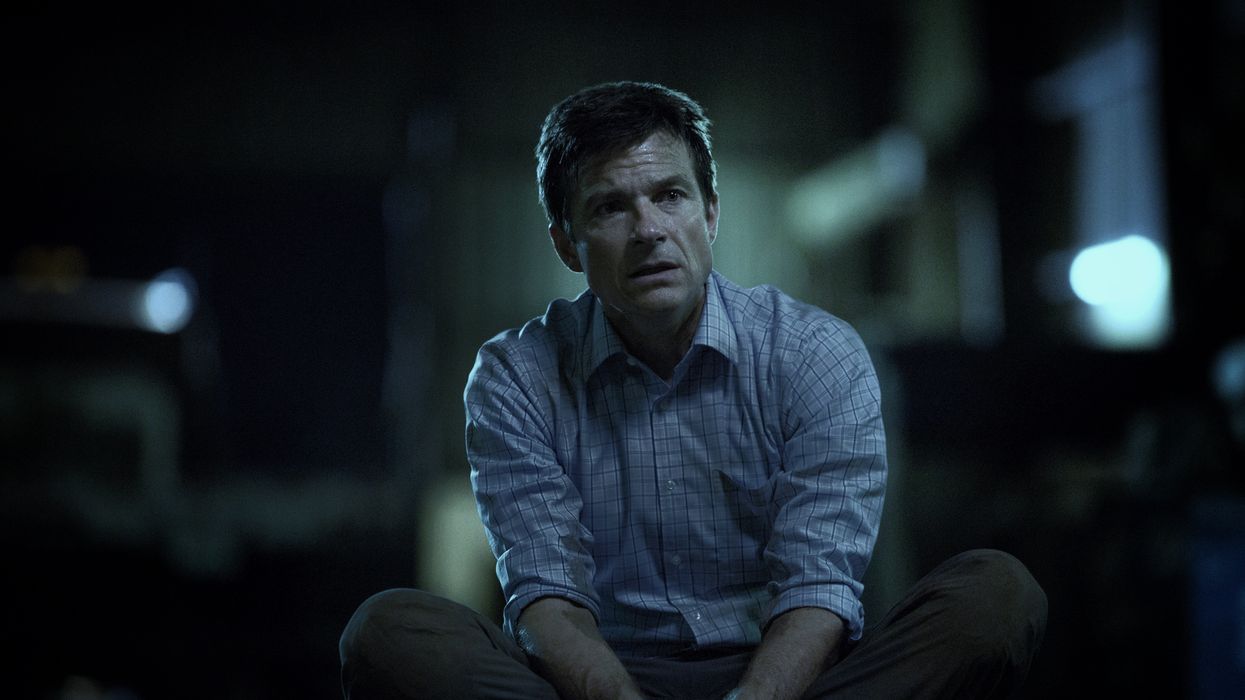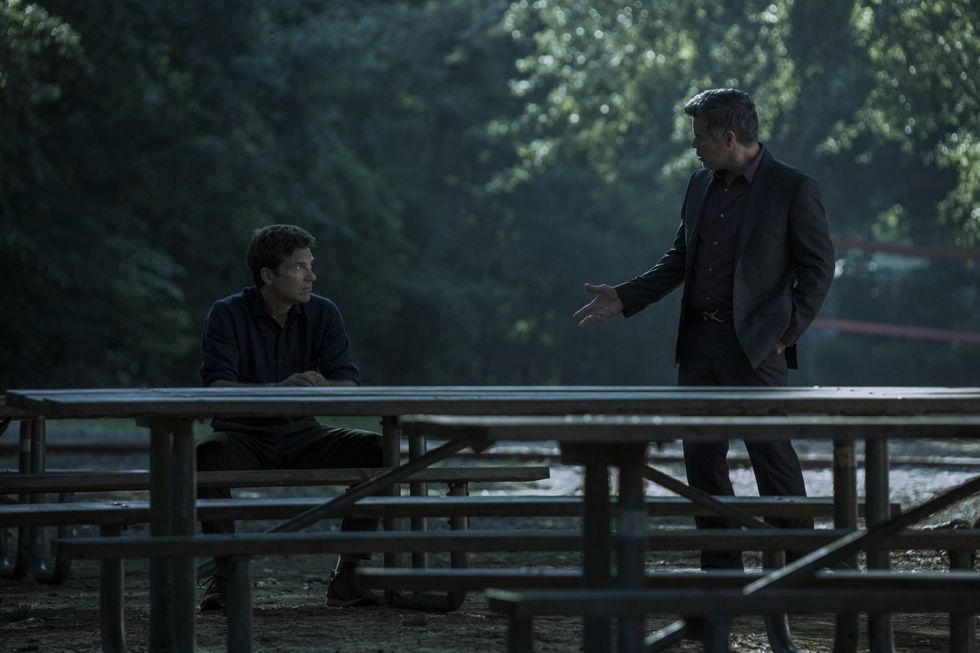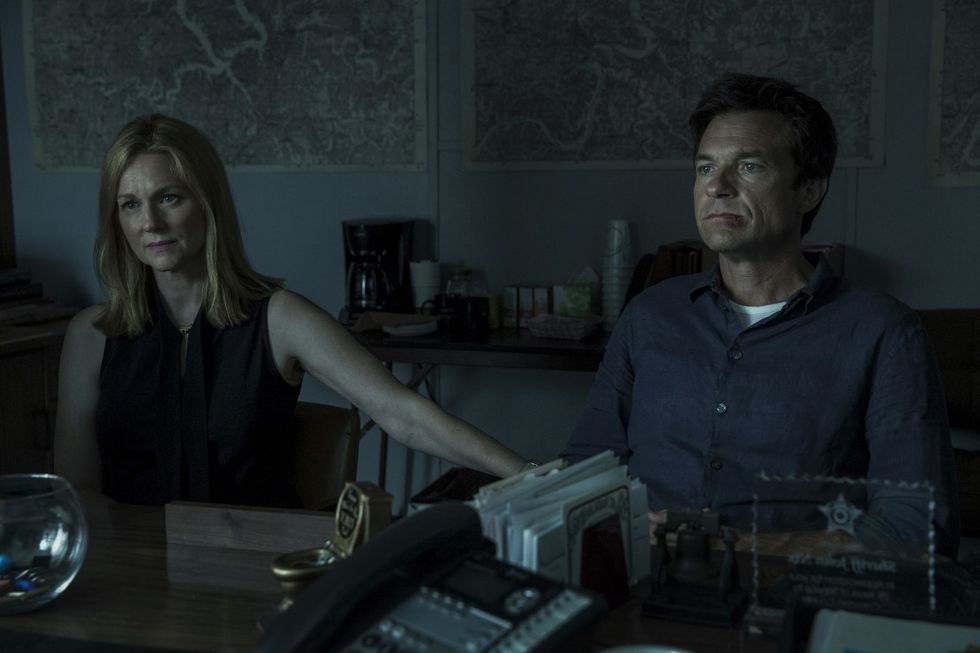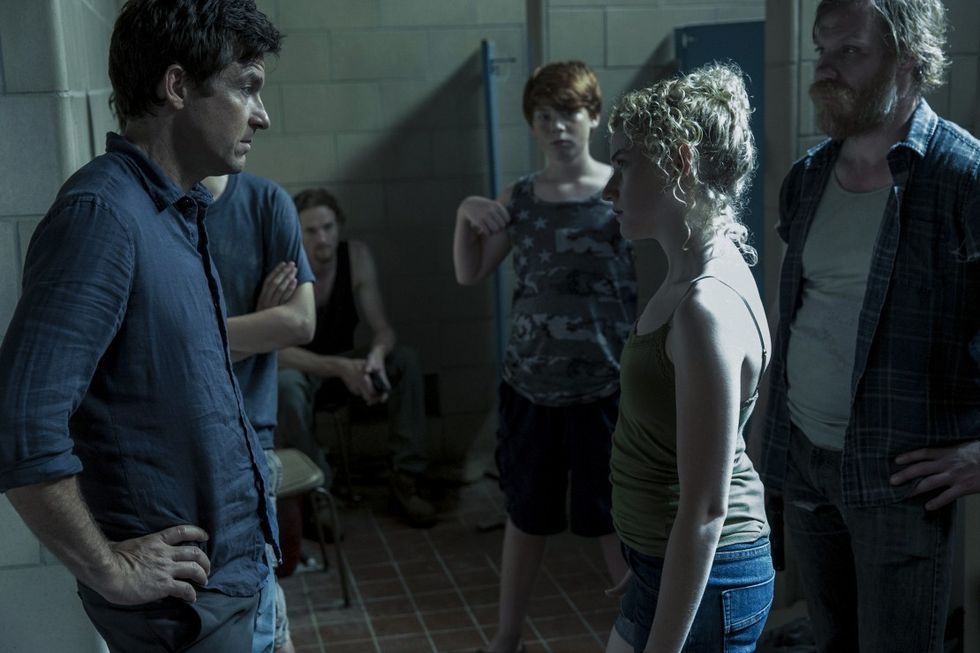How the 'Ozark' DP Created a ‘Gritty, Authentic Vibe’ with Consistent Color Temps and Practical Lighting
'Ozark' cinematographer Pepe Avila del Pino used 'subconscious' techniques to create a more cinematic crime-drama.

When crafting the world of a show like Ozark, much of the visual style and the storytelling are derived from the titular location. Driven by a blue-gray color palette, shadowy practical lighting, and striking locations, the cinematography of the new Netflix show engineers a grounded visual approach to match the grimy and grounded world of the backwater Missouri Ozarks.
Ozark tells the story of Marty Byrde (Jason Bateman), a Chicago-based financial advisor and covert money launderer, who uproots his wife, Wendy (Laura Linney), and two children, when his business with a drug cartel goes awry. With only a half-baked plan, Marty takes his family to the Ozarks, where he must create one of the world's biggest money laundering operations in order to keep the cartel from murdering him and everyone he loves.
"We shot everything at 4,400 Kelvin temperature, interiors and exteriors, day and night likewise."
Shot primarily in and around Atlanta, DP Pepe Avila del Pino duplicated the success he found on Quarry that has made him one of the hottest cinematographers in television right now. Working intimately with director, producer, and star Jason Bateman to capture the perfect look for this unique world, del Pino pushed all the right buttons to help make the Ozarks just as much of a character as Marty and the rest of the Byrde family.
No Film School sat down with del Pino to chat about the recently-released Netflix show, diving into how he learned about directing from Bateman, shooting in tight spaces, and manipulating camera temperature to capture your tone.

No Film School: You attended film school at NYU, but before that, you were a filmmaker in Mexico. Why did you decide to make that change?
Pepe Avila del Pino: I was very young when I did that, and I thought I was ready to start working on my own feature films. I had a friend who was attending NYU back then, and he basically told me, “you don’t know anything about filmmaking. Yet.” [Laughs]. He told me “the opportunity to do films with people from different backgrounds from all over the world in a city like New York is really creatively challenging and engaging.”
So I came, I applied, and I got a bit of a scholarship. I decided to test film school for like six months, and after that, I decided it was so much more than I thought it could be.
NFS: And it seems like you’ve made some really good connections there. In your previous NFS interview, you mentioned getting onto TV show Quarry at least in part because of your working relationship with Logan Marshall-Green. Was it another connection from film school that got you with Ozark?
del Pino: No, actually. Ozark came from Quarry.
I don’t know why but somehow Jason Bateman saw a little bit of Quarry before it even aired, He reached out to me and Roshelle Berliner, who was the production designer of Quarry because he wanted a similar gritty, authentic vibe. He interviewed us, and we were both in.
"One of the things that I love as a filmmaker, cinematographer, and director, is to try to be consistent in atmosphere."
NFS: What was it that really attracted you to the project and made you want to deliver this story from the page to the screen?
del Pino: It really started with the show’s title. It was all about portraying this area of the country. I started reading and researching a lot, and I was so attracted to the people, the surroundings, the area, the things that are hidden in the mountains and around the lake—this kind of world and atmosphere that was one of the main characters of the story. I wanted to try to recreate that.
One of the things that I love as a filmmaker, cinematographer, and director, is to try to be consistent in atmosphere. That’s something that I really enjoy. And it seemed like this was kind of a challenge to do that. To be consistent with creating our version of the Ozarks.
NFS: How did you approach contrasting Chicago with the Ozarks?
del Pino: We shot almost everything in Atlanta aside from like a week in Chicago for exteriors and a week at the lake of the Ozarks. When we shot in Chicago, we tried to embrace everything that was the opposite of what we were shooting at the Ozarks. All this steel and concrete and big blue clear skies and straight lines, as opposed to all the greenery and the fog and stuff that we shot in Atlanta as the lake.
NFS: How important was it for you to get onto both of those first two episodes then? To make sure you captured both Chicago and the Ozarks?
del Pino: It was important for many reasons. The first two episodes really work together. The family is removed from its place at the end of episode one, and then they start their new life in episode two. Those episodes are very important to set up what the show is going to be.

NFS: What camera did you shoot on?
del Pino: We used the Panasonic VariCam. It has a dual-ISO with an 800 and a 5,000 ISO, which is interesting. And we used the VariCam because Netflix requires shooting every show on native 4K.
We did a lot of tests with the VariCam and the RED, and I was really happy with what the VariCam was giving us. We found that we were a little afraid of how the RED camera handles greens. We were going to be surrounded in greens while shooting summer in Atlanta, and the RED just looked a little too digital.
"We were going to be surrounded in greens while shooting summer in Atlanta, and the RED just looked a little too digital."
NFS: The blue-tinted color palette wound up being something of a defining trait. Did you use any gels or filters to achieve that look?
del Pino: No, not really. The only thing we did was that we shot everything at 4,400 Kelvin temperature, interiors and exteriors, day and night likewise. And because we tried different color temperatures when we were doing tests, we saw that using that setup would give us the most ability to keep that consistent cooler grayish/blueish palette. But no filtration.
NFS: And the lighting really stood out too. There are a lot of shadows involved. What was your lighting strategy?
del Pino: I talked a lot with Roshelle to establish that. We tried to do a lot with practical.
The scene in the warehouse where Del is killing all of Marty’s associates was a good one. That was an empty warehouse, and there’s a bunch of ways to approach that, but we placed fluorescent tubes all around. They’re in almost every frame, and they give us a sense of space in this big, dark room. It doesn’t feel lit like a Hollywood film, so it keeps this gritty and dark mood.
And for day interiors, one thing that I pitched to Jason was to let the shadows fall and let the darkness take over a little bit of the frame, even if it’s a bright day outside. That gives a sense that there’s some sort of hiding. Kind of like when you go into a cave, and the only light is coming from outside, and it's falling fast into darkness.

NFS: You mention that scene in the warehouse, and the scene immediately preceding it was probably my favorite scene in the episode - where Del is feeling out the guys about stealing money from him. What do you do as a DP to really capture the tension of a moment like that?
del Pino: That was a tough shoot because it’s a long page count and a square space. It’s basically a box where we’re shooting, and there’s not much movement. Me, Jason, and the camera operator, Bud Kremp, were bouncing around ideas, and I think in the end we came up with what’s fitting.
We start by having a camera wrap around Del a little bit while he’s doing his monologue, but then suddenly we’re long lens across the other characters and feeling a little bit more hectic and random with the actions. The camera language and lensing changes throughout the scene. It was basically something where we were all pitching ideas, and ultimately I think Jason made the right choice, followed his gut, and it worked out really well.
"We used Hawk V-Lite’s and Hawk Vintage to add a little bit of texture and for cropping in the anamorphic aspect ratio."
NFS: What lenses did you use for most of the shoot?
del Pino: It later changed, but for the first two episodes, we used Super Speeds for day exterior and Cooke S4’s for the rest. And for Chicago, we used Hawk V-Lite’s and Hawk Vintage. The reason for that was to add a little bit of texture and for cropping in the anamorphic aspect ratio. We actually had an interesting aspect ratio in this, since it was 2:1, but it worked, and Netflix liked it.
NFS: How come you chose that aspect ratio?
del Pino: We wanted something that would subconsciously add to the idea that it’s a little more cinematic; that happens when you see a wider aspect ratio. But we couldn’t do that much because then people are losing a lot of image in their computers - they’ll be seeing black lines. So it was a compromise. And for a few scenes in Chicago, when we started cropping the anamorphics it gave an interesting claustrophobic feeling.
NFS: As a director yourself, what sort of knowledge did you pick up from collaborating with Jason Bateman?
del Pino: I was really amazed with Jason. He’s been on set for most of his life, so I’m just amazed at how easily he would shape a scene with very few, very subtle directions. Suddenly a scene that involves six or seven actors would turn in the direction he wanted it to.
I think what I got off him is to find the three or four things you need to tell, particularly to the persons that are shifting the scene, and let it happen, instead of trying to push everyone work in one direction.
NFS: Did you have any exciting tech on the shoot? There’s one shot in particular with a crane that was really cinematic, where Marty drops the sandwich into the lake.
del Pino: That was a crane that we put on a Raptor Base from Chapman, which is basically a tank that auto-levels itself because it’s a cliff. There were no roads or anything smooth there. So it was a thirty-foot crane, and we did as much as we could going over his head and around him and that was fun. I think that was one of the biggest toys we had. That and the helicopter we used at the end of the first of episode where the whole family is standing at the edge of the cliff, and we pull out.

NFS: So what was your most challenging shot?
del Pino: The fall of Wendy’s lover when they drop him from his apartment. We did that practically with a dummy, so it was complicated. We were dropping it from a 60-foot tall crane in the middle of a street in Chicago. We had several camera positions and the timing of the thing falling with the camera move, with the reaction—everything was complicated.
And there’s one shot I really like that I think is simple, subtle and cinematic. When Marty talks his way out of Del killing him at the warehouse, he gets back home, and he’s talking to his wife, Wendy, and he’s emptying his safe box in his bedroom. That’s a one-shot. It’s like four minutes of dialogue, but nobody notices because it doesn’t feel it. I think the blocking and the movement of the camera is elegant, it’s simple, it’s evolving with the stress, the action, their relationship. I think it’s one of those things that I have a lot of pride about achieving because it's not too obvious.
NFS: On your site, you mention that you have a philosophy background. Do you try to integrate that into your work as a DP?
del Pino: Philosophy is important for me when I write, but I never thought about what it did for me as a DP. But in the end, I just try to be a storyteller, whichever medium it is. As a cinematographer, I try to find the shot that is most powerful and can move the story. Or move you emotionally. How do you find that shot? How do you make it powerful and effective?












